Hi,
I have been experimenting with full range equalisation with REW for a few days, and I'd like to discuss the topic of Target curves for a stereo 2.0 system. Strangely enough, I wasn't satisfied at all with the proposed target curve in REW, and I ended with a somewhat different one.
I came to REW and parametric equalisation since I replaced my hifi speakers (Dynaudio Gemini, then Kef R-300) with Neumann KH-120 monitors. They are active monitors with a flat response until 50 Hz, which triggers two room modes at 55 and 70 Hz that are absolutely unbearable.
The hifi speakers had an attenuated response at these frequencies, and I could play with the bass reflex opening, but with the Neumann, although the mids and highs sound much more natural, for low frequencies, equalisation couldn't be avoided.
The question of the target curve is especially interesting with the Neumann because they are supposed to sound completely flat in anechoic conditions, or that's what they claim. Here is an independent measurment of these speakers : http://kenrockwell.com/audio/neumann/kh-120-a.htm
Therefore what I measure with REW at the listening position should reflect the room gain more than the speakers response.
I use a Umik microphone in vertical position, with the standard calibration file (the Umiks are not calibrated one by one, instead, the file is supposed to fit a whole batch with the same serial number).
First, here are the measurements before equalisation. These are the average of 6 measurement for each speakers, separated by about 40 cm from each other, so as to match a wide range of possible listening positions.
![Image]()
![Image]()
All of the next curves (except the 0.9 db slope ones) differ from the reality because of the activation of -1 dB treble correction directly on the speakers, that isn't taken into account in the predicted result. I set the treble at -1 according to my liking, as the user manual explains that the treble level must be set according to the kind of acoustic - bright or damped- the speakers are installed in.
Anyway, here is the measured effect of the switch. This is nothing to worry about. It might even be lower than the accuracy of the Umik (don't take the general look of the curve into account, the tone controls of the preamplifier were mistakenly turned on during both measurements).
![Image]()
I first targeted the curve proposed by REW, which lead to this :
![Image]()
![Image]()
On the graph, it looks ok. But in real life, there seem to be a good lack of low frequencies. The sound is thin... and at the same time, the bass, below 100 Hz are too loud.
Then I decided to try the following : since the Neumann are supposed to sound neutral, let them do, and just equalize the low frequencies flat.
I decided to ignore the high frequency part of the curve, and to align the target curve with the measured curve in the 1 - 2 kHz range, where they have exactly the same slope.
Following the measured curve towards the low frequencies, I tried this : a flat target curve with a knee at 400 Hz, then -1.8 dB / octave (the original slope proposed by REW). The target level for bass equalisation being given by matching the measured and target curves between 1 kHz and 2 kHz.
![Image]()
![Image]()
And wow ! That sound much better. Although the bass are not perfect yet.
I then tried another idea : to completely follow the Neumann measured response in the mid-highs and continue with the same slope across the whole frequency range. That leads to a 0.9 dB / octave curve. Here is the predicted result :
![Image]()
![Image]()
Aaaarg ! That sounds terrible ! Muffled.
I came back to the previous curve, with the knee at 400 Hz, and I tried to move the knee to 200 Hz (more bass), or 600 Hz (less bass). The result were audible inferior. The sound seems balanced when the knee is at 400 Hz.
This week, I went further and tried to fill the notches in the 100 - 200 Hz range. That lead to a great improvement. The bass were cleaner, and more natural.
Listening to my new equalisation today, I found that there was still a little annoyance in the low mids, especially in choral music, but also in metal. I again tried to move the knee of the target curve to the right, but that was not good, as the mids sound too loud on solo voices.
I wondered if the problems didn't come from the remaining little oscillations between 300 and 1 kHz. They might very well be high order room modes. The speakers are standing 80 cm away from the rear wall, which causes two dips, one just below 100 Hz and the other just below 300 Hz. Maybe there are other ones.
I then carefully equalized them, checking in the overlay view of REW the 6 separate measurements to ensure that the corrections I was doing were valid for a wide enough set of listening positions.
The corrections are small, but I think that the problem in the low-mid is now reduced. The current result sound incredibly well balanced. Here are the predicted psychoacoustic curves :
![Image]()
![Image]()
And the filters used :
![Image]()
![Image]()
For the time being, the correction is done in Foobar2000's convolver, but I should soon get my MiniDSP and load the correction for all sources. I can't wait !
Now I'd like to hear about other people's experiments with the target curve. Do you actually feel the need to increase the bass level below 100 Hz ? Are you satisfied with the low-mids (200 - 800 Hz) ?
I have been experimenting with full range equalisation with REW for a few days, and I'd like to discuss the topic of Target curves for a stereo 2.0 system. Strangely enough, I wasn't satisfied at all with the proposed target curve in REW, and I ended with a somewhat different one.
I came to REW and parametric equalisation since I replaced my hifi speakers (Dynaudio Gemini, then Kef R-300) with Neumann KH-120 monitors. They are active monitors with a flat response until 50 Hz, which triggers two room modes at 55 and 70 Hz that are absolutely unbearable.
The hifi speakers had an attenuated response at these frequencies, and I could play with the bass reflex opening, but with the Neumann, although the mids and highs sound much more natural, for low frequencies, equalisation couldn't be avoided.
The question of the target curve is especially interesting with the Neumann because they are supposed to sound completely flat in anechoic conditions, or that's what they claim. Here is an independent measurment of these speakers : http://kenrockwell.com/audio/neumann/kh-120-a.htm
Therefore what I measure with REW at the listening position should reflect the room gain more than the speakers response.
I use a Umik microphone in vertical position, with the standard calibration file (the Umiks are not calibrated one by one, instead, the file is supposed to fit a whole batch with the same serial number).
First, here are the measurements before equalisation. These are the average of 6 measurement for each speakers, separated by about 40 cm from each other, so as to match a wide range of possible listening positions.

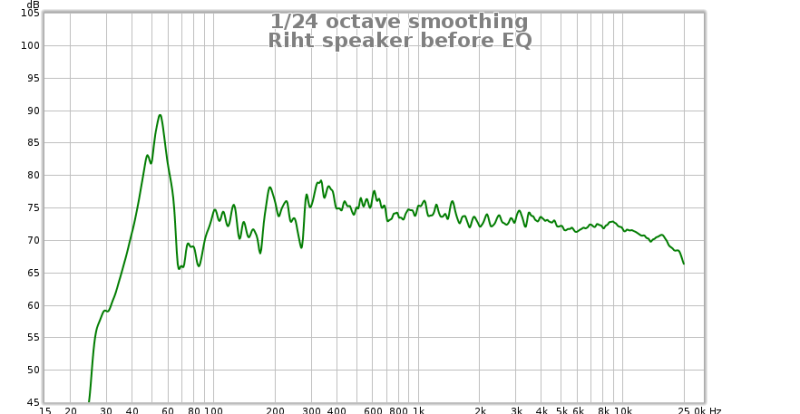
All of the next curves (except the 0.9 db slope ones) differ from the reality because of the activation of -1 dB treble correction directly on the speakers, that isn't taken into account in the predicted result. I set the treble at -1 according to my liking, as the user manual explains that the treble level must be set according to the kind of acoustic - bright or damped- the speakers are installed in.
Anyway, here is the measured effect of the switch. This is nothing to worry about. It might even be lower than the accuracy of the Umik (don't take the general look of the curve into account, the tone controls of the preamplifier were mistakenly turned on during both measurements).

I first targeted the curve proposed by REW, which lead to this :


On the graph, it looks ok. But in real life, there seem to be a good lack of low frequencies. The sound is thin... and at the same time, the bass, below 100 Hz are too loud.
Then I decided to try the following : since the Neumann are supposed to sound neutral, let them do, and just equalize the low frequencies flat.
I decided to ignore the high frequency part of the curve, and to align the target curve with the measured curve in the 1 - 2 kHz range, where they have exactly the same slope.
Following the measured curve towards the low frequencies, I tried this : a flat target curve with a knee at 400 Hz, then -1.8 dB / octave (the original slope proposed by REW). The target level for bass equalisation being given by matching the measured and target curves between 1 kHz and 2 kHz.


And wow ! That sound much better. Although the bass are not perfect yet.
I then tried another idea : to completely follow the Neumann measured response in the mid-highs and continue with the same slope across the whole frequency range. That leads to a 0.9 dB / octave curve. Here is the predicted result :


Aaaarg ! That sounds terrible ! Muffled.
I came back to the previous curve, with the knee at 400 Hz, and I tried to move the knee to 200 Hz (more bass), or 600 Hz (less bass). The result were audible inferior. The sound seems balanced when the knee is at 400 Hz.
This week, I went further and tried to fill the notches in the 100 - 200 Hz range. That lead to a great improvement. The bass were cleaner, and more natural.
Listening to my new equalisation today, I found that there was still a little annoyance in the low mids, especially in choral music, but also in metal. I again tried to move the knee of the target curve to the right, but that was not good, as the mids sound too loud on solo voices.
I wondered if the problems didn't come from the remaining little oscillations between 300 and 1 kHz. They might very well be high order room modes. The speakers are standing 80 cm away from the rear wall, which causes two dips, one just below 100 Hz and the other just below 300 Hz. Maybe there are other ones.
I then carefully equalized them, checking in the overlay view of REW the 6 separate measurements to ensure that the corrections I was doing were valid for a wide enough set of listening positions.
The corrections are small, but I think that the problem in the low-mid is now reduced. The current result sound incredibly well balanced. Here are the predicted psychoacoustic curves :
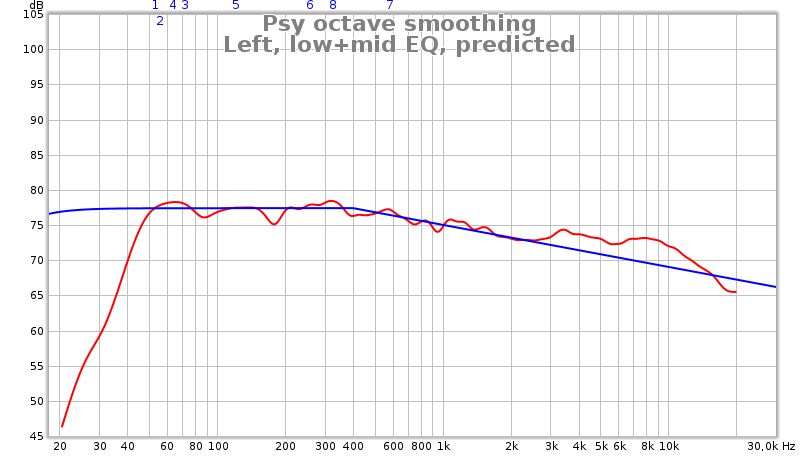
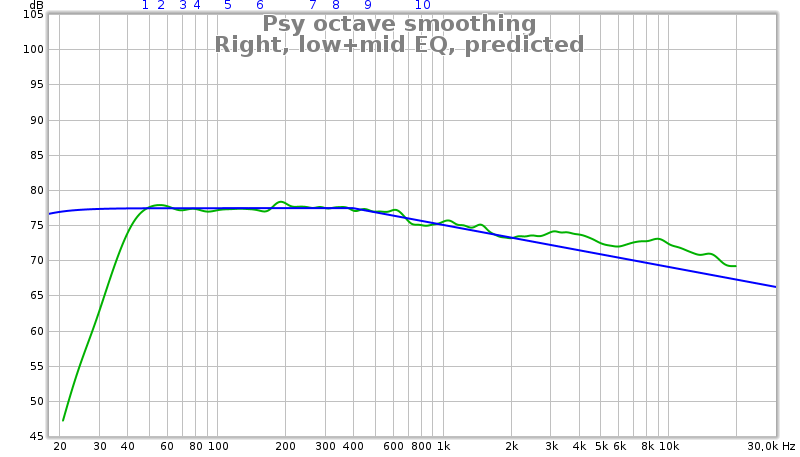
And the filters used :
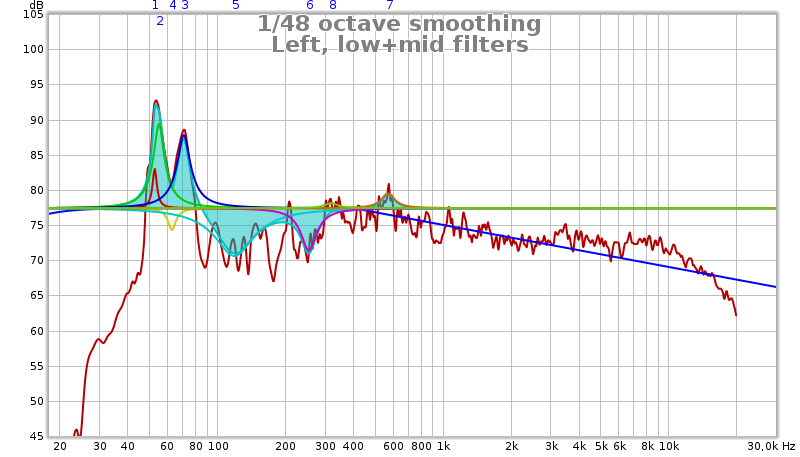
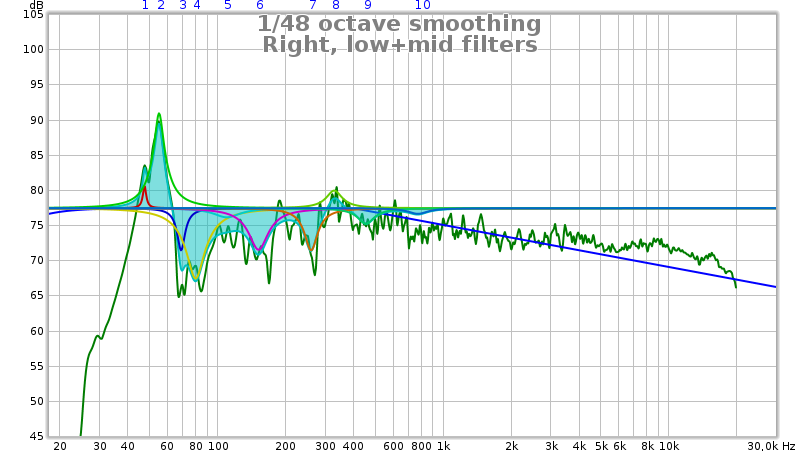
For the time being, the correction is done in Foobar2000's convolver, but I should soon get my MiniDSP and load the correction for all sources. I can't wait !
Now I'd like to hear about other people's experiments with the target curve. Do you actually feel the need to increase the bass level below 100 Hz ? Are you satisfied with the low-mids (200 - 800 Hz) ?




